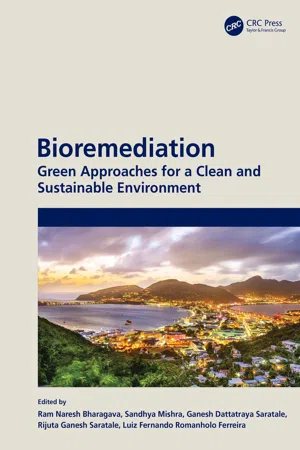
Bioremediation
Green Approaches for a Clean and Sustainable Environment
- 268 pages
- English
- ePUB (mobile friendly)
- Available on iOS & Android
Bioremediation
Green Approaches for a Clean and Sustainable Environment
About This Book
Environmental sustainability with rapid industrialization is one of the current major global challenges. Industries are the key drivers of the world economy. But they are also the major polluters of the environment due to the discharge of partially treated/untreated toxic and hazardous wastes containing organic and inorganic pollutants, which cause severe environmental (soil and water) pollution and toxic effects in living beings. So the adequate treatment of industrial wastes to degrade/detoxify pollutants is of the utmost importance for environmental safety and for promoting the sustainable development of our society with low environmental impacts.
Bioremediation: Green Approaches for a Clean and Sustainable Environment showcases the latest information on the different bioremediation approaches used for the many types of industrial pollutants and are dedicated to environmental safety. This book provides a detailed knowledge about the natural as well as anthropogenic sources of different types of toxic pollutants, such as toxic metals, dyes, pesticides, petroleum hydrocarbons and plastics; their fate and transport into the environment; their ecotoxicological effects and health hazards; and different approaches used for their bioremediation for the environmental clean-up.
Key Features:
-
- Covers the different aspects of environmental problems and their remedies with up-to-date developments in the field of bioremediation of industrial/environmental pollutants
-
- Serves as an invaluable source of knowledge for a wide range of students, scientists, and researchers in microbiology, biotechnology, environmental sciences with the fundamental and advanced knowledge about the environmental pollution, challenges, and bioremediation of toxic pollutants
Frequently asked questions
Information
1 Existing and Emerging Treatment Technologies for the Degradation and Detoxification of Textile Industry Wastewater for the Environmental Safety
CONTENTS
- 1.1 Introduction
- 1.2 Characteristics and Pollutants of Textile Industry Wastewater
- 1.3 Toxicity Profile of Textile Industry Wastewater
- 1.4 Existing and Emerging Treatment Technologies
- 1.4.1 Biological Treatment
- 1.4.1.1 Enzymatic Treatment
- 1.4.1.2 Phytoremediation (Plant Treatment)
- 1.4.2 Advanced Oxidation Processes (AOPs)
- 1.4.3 Combination of AOPs and Biological Treatment Methods
- 1.4.1 Biological Treatment
- 1.5 Challenges and Recommendations
- 1.6 Conclusions
- Acknowledgement
- References
1.1 Introduction
Table of contents
- Cover
- Half Title Page
- Title Page
- Copyright Page
- Table of Contents
- Preface
- Editors
- Contributors
- 1. Existing and Emerging Treatment Technologies for the Degradation and Detoxification of Textile Industry Wastewater for the Environmental Safety
- 2. Nanotechnology: A Valuable Asset Contribution to Positive Impact on Environment
- 3. Wastewater Treatment Using Biochar-Amended Constructed Wetland Systems
- 4. Treatment of Metalworking Effluent: Chemical Precipitation, Advanced Oxidative Processes and Biological Treatments
- 5. Reducing Heavy Metal Toxicity using Biochar as a Naturally Derived Adsorbent
- 6. Bioremediation of Potentially Toxic Metals by Microorganisms and Biomolecules
- 7. Bacterial Biofilm Formation for the Remediation of Environmental Pollutants
- 8. Sustainable Development in Agriculture by Revitalization of PGPR
- 9. Exploitation of Silver Nanoparticles in Bioremediation
- 10. Role of Nano-Biotechnology in Solid Waste Management
- 11. A Sustainable Approach to the Degradation and Detoxification of Textile Industry Wastewater for Environmental Safety
- 12. Ecological and Health Implications of Heavy Metals Contamination in the Environment and Their Bioremediation Approaches
- 13. Biogenic and Non-Biogenic Waste for the Synthesis of Nanoparticles and Their Applications
- 14. Use of Nanoparticles in Bioremediation of Pharmaceutical Compounds
- 15. Heavy Metal Remediation through Nanoparticles
- 16. Applicability of Plants in Detoxification of Dyes
- Index